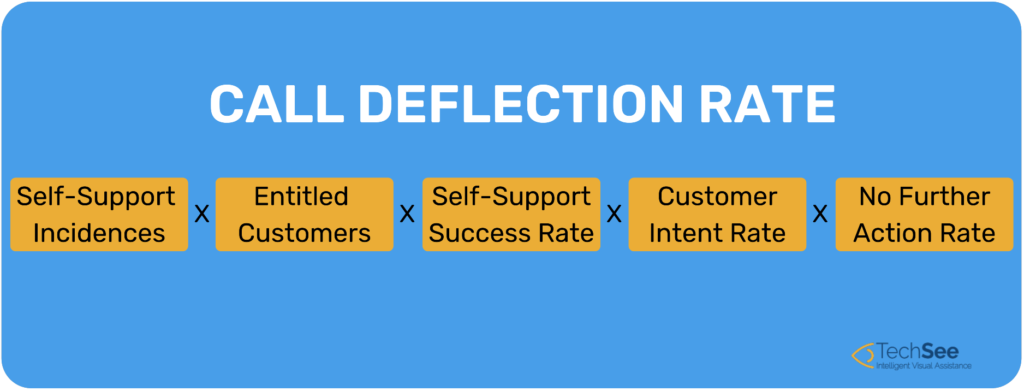Contents
- Call Deflection Meaning
- How Is Call Center Deflection Calculated?
- How Does Call Deflection Work?
- How Much Does Call Deflection Cost?
- The Benefits of Deflecting Calls
- Frees Up Customer Support Agents
- Shorter Waits, Faster Resolution for Customers
- Increases Customer Satisfaction
- Encourages the Use of Resources You Already Have in Place
- Reduces Overall Customer Support Costs
- Reduces Customer Support Agent Turnover & Overall Headcount
- Reasons Call Deflection Sometimes Doesn’t Work
- Top 4 Call Deflection Strategies
- How to Implement Strategic Call Deflection
- Is Call Deflection the Solution to Rising Call Center Volumes Worldwide?
Increasing call center volumes are becoming a problem for companies worldwide. Customers are frustrated by wait times and are, therefore, more likely to leave negative reviews, putting more stress on your customer support agents and company as a whole.
High customer expectations combined with digital transformation and human capital shortages have highlighted the importance of implementing new strategies to stay competitive in call centers.
So, how can you reduce customer frustrations and improve customer support efficiency? Two words: Call Deflection.
Companies are using call deflection to reduce call center volume, lessening the workload of their staff and allowing them to focus only on the most complex cases.
Learn more in this TechSee report on Reducing Call Center Volume with Computer Vision AI
Call Deflection Meaning
Call deflection is the strategy of transferring customers to a different channel than your call center agents to find resolution. While it may seem as though you’re putting your customers’ needs on the back burner, the goal of call deflection is to reroute them to an alternative service channel that can serve them faster and more efficiently. You are essentially able to reduce call volume by proactively providing self-support to your customers. The goal is both to ensure customers receive the answers they are seeking in the most efficient manner and to reduce the number of inbound calls routed to human agents; deflecting the calls.
| What Call Deflection Is | What Call Deflection Is Not |
|---|---|
| Providing an alternative service channel for customer service | Bypassing interaction with humans |
| Routing customer calls efficiently | Rerouting to numerous customer service channels |
| Enhancing CX by offering preferred channels of communication for issue resolution | Reducing call center volume and cost in exchange for dissatisfied customers |
How Is Call Center Deflection Calculated?
To calculate call center deflection, you first must gather the data from your calls. Your call deflection rate can then be measured by multiplying the number of self support incidences by the number of entitled customers. You then would multiply this number by the customers’ success rate in resolving their issues with the use of the self support methods provided to them.
Next, you must multiply your findings by the intent rate. This refers to the percentage of customers who found resolution but requested assisted support should they not find answers to their questions via the self-support methods.
To finally establish your call deflection rate, you will need to multiply your findings by the no further action rate. The no further action rate is the percentage of customers who found an answer to their problem, indicated that they would like assisted support should they not find resolution, and also indicated that no further action was needed to fix their problem.
To illustrate this more simply, here is how you can calculate your call deflection rate:
How Does Call Deflection Work?
Call center deflection works by giving customers proactive support or by rerouting them to alternative digital channels that can help them find a solution to their problem without having to speak to a customer support agent. Some of these digital channels include but are not limited to:
- Visual self-guided support (Visual Journeys)
- Live chat
- SMS or messaging applications
- Knowledge bases
- In-app guides
- Interactive onboarding
- Community forums
- FAQ page
Call deflection ensures that your agents only receive calls that cannot be resolved through any other source. In addition to taking the pressure off your agents, call center deflection gives your customers full control of their resolution journey. Here is an example of a visual, self-guided call deflection journey of a customer needing help on a coffee machine:
The truth is,customers prefer self-help options over having to reach out to live representatives. In fact, a study by Harvard Business Review shows that 81% of customers try to find resolution on their own before reaching out to customer support teams.
How Much Does Call Deflection Cost?
The cost of call deflection depends entirely on how you decide to implement it. However, with phone-based customer support calls costing up to $50 per interaction, the cost of not optimizing for call deflection could be far more than the initial monetary expense of investing in . creating self-support options for your customers.
Not only this, a study by McKinsey and Company highlighted that companies that also use digital customer service solutions rather than only relying on call center support reduced their overall support expenses by up to 30% all while boosting customer satisfaction by up to 19%.
With the use of these self-support digital channels, agents can interact with multiple people at the same time, boosting their productivity and providing customers with a higher level of service.
The Benefits of Deflecting Calls
As mentioned above, the cost of not implementing call deflection in your call centers far outweighs the original operational expenses of putting a strategy in place. Here are just some of the reasons you would benefit from deflecting calls:
Frees Up Customer Support Agents
With the correct call deflection strategy you are giving time back to your agents so that they can focus on answering high-touch calls that cannot be addressed using any other method of support.
Shorter Waits, Faster Resolution for Customers
Today, customers are used to getting what they want, when they want it. This fast-paced way of interacting with companies means that they no longer want to wait on the phone to get solutions to their problems. Call deflection speeds up the resolution process by giving them back full control.
Increases Customer Satisfaction
By reducing the amount of time that customers spend on the phone, and on hold waiting for agents to find solutions to their problems, you can be sure to keep your customers happy. This, combined with the fact that customers actually prefer self-support alternatives will lead to a boost in customer satisfaction rates.
Encourages the Use of Resources You Already Have in Place
Call deflection often involves sending your customers to self-service solutions you already have in place on your website or other digital channels. With the right call deflection method, your customers will support themselves by design, freeing up your agents to focus on other calls.
Reduces Overall Customer Support Costs
Aside from freeing up agents to focus on more advanced customer issues, you also reduce the overall number of agents you need in your call center. When you implement an effective call center deflection strategy, you receive fewer inbound calls, reducing your overall customer support costs.
Reduces Customer Support Agent Turnover & Overall Headcount
With fewer basic calls, your team will be happier and more efficient in their job. Thanks to this increase in work satisfaction, you’ll notice a reduction in customer support agent turnover. Moreover, you’ll need fewer customer support agents as your overall call volume will be lower.
Reasons Call Deflection Sometimes Doesn’t Work
One of the key reasons that call deflection sometimes doesn’t work is because it is often misunderstood for callbacks. While callbacks can help reduce wait queues, they do not offer any form of instant resolution to the customer, thus not providing the customer satisfaction seen in effective call deflection strategies. Remember, the goal of call deflection is to reduce the volume of calls your agents receive, not to delay them.
Top 4 Call Deflection Strategies
Implementing a call deflection strategy can support your customers no matter where they are in their buyer journey. The key, however, is to implement the most relevant strategy to your company according to your client base and the volume of calls you receive. Here are four tried and tested call deflection methods:
Take a Proactive Approach
When it comes to implementing a call deflection strategy, there is no better way to stay ahead of the game than by identifying and resolving customer issues before they occur. In simple terms, aim to provide your customers with all of the information they need to use your service or product from the channels that are already available to them (i.e. your website, social media channels, and so on). It is highly recommended that you include onboarding and self-support as part of the setup process.
It’s also important that you analyze and understand the calls that you are currently receiving in order to address common issues. If you find your agents are answering the same questions over and over again, aim to deflect callers to some of your low-touch customer support channels such as your blog, website, FAQ sections or knowledge bases.
Redirect Them to Your Self-Service Channels
Your website should be packed with useful information that leads your customers not solely towards a purchase but also towards resolution when they experience issues. Some informational elements to include on your site are:
- A blog
- A knowledge base
- Detailed guides
- White papers
- FAQs
- Webinars
- How-to guides
Be sure to inform your customers of your alternate service channels where appropriate. Whether it be automated emails, website notifications, or messaging services, provide them with the relevant options available to them to minimize the volume of calls you receive.
But, be sure to find a balance between letting them know about your self-support options while also not keeping them on hold for too long when informing them of these in order to not reduce their overall customer experience.
Use Conversational AI
With technology advancing at an astronomical rate, more companies worldwide are implementing conversational AI, or chatbots, on their websites.
Today, companies aim to deflect 90% of their calls with the use of chatbots, and for good reason. This form of Artificial Intelligence is becoming increasingly smart, allowing them to optimize call deflection and scale one-on-one conversations with clients, thus freeing up agents so that they can focus on more advanced customer queries.
It is important to note, however, that chatbot technology is still not perfect and when ineffective, can be frustrating for customers. With this in mind, be sure to use this technology appropriately and have more effective and advanced solutions in place for when chatbots can’t quite step up to meet your customers’ needs, such as customer service tools empowered by computer vision AI.
Implement Computer Vision AI
While similar to conversational AI, Computer Vision AI uses the camera on your customers’ smartphones or computers to process and analyze videos and digital images. By doing so, it can understand context, allowing it to identify problems and provide customers with solutions in self-service mode.
Considered one of the world’s newest and best forms of call deflection, Computer Vision AI can identify issues faster while also providing clearer and more advanced self-service solutions. This, in turn, can reduce contact center call volumes, boost agent performance, and enhance customer experience.
How to Implement Strategic Call Deflection
While the above strategies can support you in reducing call volumes, it’s important that you implement it in a way that will allow you to provide your customers with a positive experience. Here are some best practices to keep in mind:
Configure Your Strategy to Serve Customers Before They Call You
Your call deflection strategy should serve your customers before they pick up the phone. Your goal is to reduce the number of calls or messages to your call centers so that your agents can handle calls faster and more efficiently. With this in mind, aim to provide them with resolution before they pick up the phone.
The likelihood is, your customers will head straight to your contact page to find your phone number if they face an issue. Conversational and Computer Vision AI are a great way to grab your customers’ attention and provide them with solutions to their problems before they pick up the phone.
Undertake a Comparison Analysis
It’s important that you compare your call center’s performance from one week to the next. To do this, keep an eye on your Average Speed of Answers (ASA) times, First Time Resolution (FTR) rates, and your overall call volumes. Analyzing performance will ensure that you meet your customer service goals while also helping you identify patterns for implementing an effective and relevant call deflection strategy.
Use the Correct Tools for Your Business
Before you can implement an efficient call deflection strategy, you have to make sure that you’re using the correct workforce management tools. Understanding your typical caller’s journey will allow you to identify popular channels in order to ensure that the right integrations are in place to streamline your communications.
Create Low-Touch Customer Support Channels
Low-touch support channels are helpful resources that customers can use to get resolution to their issues quickly without ever having to speak to a customer support agent. FAQs, white papers, webinars, and forums are just some of the resources you can put in place that will help reduce call volumes while also increasing customer satisfaction rates.
Another method of call deflection that also enhances brand loyalty is to create an online community where customers can support one another. Social media groups are a low-resource way of offering these interactive spaces where people can help each other in real-time.
Moreover, these channels are the perfect opportunity to integrate warm transfers, where customers get to speak to a customer representative via chat before resorting to speaking to a support agent on the phone. This provides the support team with a full overview of the situation, either allowing them to provide resolution or, gather information that can then be relayed to the agent who will be able to provide more effective support.
Is Call Deflection the Solution to Rising Call Center Volumes Worldwide?
Call deflection is an effective way of reducing call center volume regardless of your industry. By implementing a call deflection strategy, you can boost customer satisfaction and engagement, cut costs, and increase agent productivity.
For more information on how to integrate Computer Vision AI into your call deflection strategy, request a demo today.








